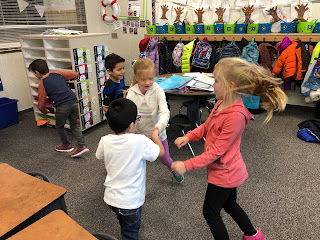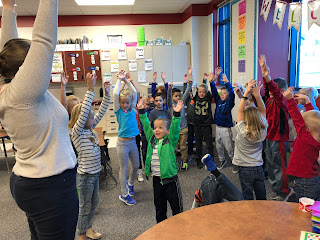Eighth Visit! (November 27, 2018)
Today was fun and full of connections! Miss Adair wanted to address some of the class issues that she has seen on the playground and in the class, so we did a process drama focused on unity. The bulk of the lesson plan that I used came from a group project devised in my Theatre for the Elementary Classroom class at BYU.
The first part of the lesson is the hook to get students engaged with what we were doing. To do this, we played a game called "Seagulls and Crabs." It is a take on triangle tag. There are at 4 people to a group: a seagull, a crab, and two walls. The goal of the game is for the seagull to tag the crab and for the wall to prevent that from happening. The focus on unity came in the form of the two walls working together with the crab to prevent the seagull from winning. The students had a lot of fun with the game and were good to take their own initiative to make sure that every had a turn to be each part.
The next part of a process drama is building trust within the classroom: trust between students and between class and teachers. To do this, everyone turned to their neighbor and talked for a couple of minutes about strengths that they have. They named their own and then some of their partner's. It was fun to hear some of the different comments: "you're good at football," "you're good at tying your shoe," you're good at saying what people are good at."
We, then, watched a video about unity. In the video, different animals banned together to save one of their group. We broke the video down a little and discussed how we saw unity from each group of animals. I was impressed with the things that the students picked up on! They got right to the point of working together to solve issues. They even tied in our machine activity from last week and related it to how we worked together as a class to make the turkey machine.
I turned the time to Miss Adair. She brought up several specific examples of things that her class needed to work on to improve their unity in the classroom; she also let the students offer examples that they have seen. As we went from situation to situation, she asked what the students thought they could do to solve the class issue. With each suggestion, Miss Adair assigned a group the task of acting out the solution that they talked about.
We gave the 5 groups time to practice what their solution to the problems would look like. After reviewing some of the key concepts of acting and being a good audience member, each group presented their solutions to the class. I was blown away by the students' creativity and their ability to act situations out! I can see how the activities that we have done all semester long have helped them build up to where they are now. I had to do very little to no side-coaching at all; these were completely student produced!
To wrap up our discussion on unity, I ask the students to think about what they could do themselves to promote more unity in the classroom and at school. Most of them gave examples that included saying stop when people break the rules, walking away from a bad situation, or telling the teacher when there is an issue. I am excited to see how this lesson affects the classroom community in Miss Adair's class.
I left the school very excited today! What the class is able and willing to do now compared to the beginning of the semester is amazing! I look back at my second visit and can see the difference. That was the first time that we tried acting something out in front of the class. The students needed a lot of coaching and were nervous to do much in front of their peers. Today, they were willing and ready to work! They produced ideas on their own and practiced good drama techniques when showing their classmates what they came up with. I couldn't be happier with the results!
The first part of the lesson is the hook to get students engaged with what we were doing. To do this, we played a game called "Seagulls and Crabs." It is a take on triangle tag. There are at 4 people to a group: a seagull, a crab, and two walls. The goal of the game is for the seagull to tag the crab and for the wall to prevent that from happening. The focus on unity came in the form of the two walls working together with the crab to prevent the seagull from winning. The students had a lot of fun with the game and were good to take their own initiative to make sure that every had a turn to be each part.
The next part of a process drama is building trust within the classroom: trust between students and between class and teachers. To do this, everyone turned to their neighbor and talked for a couple of minutes about strengths that they have. They named their own and then some of their partner's. It was fun to hear some of the different comments: "you're good at football," "you're good at tying your shoe," you're good at saying what people are good at."
We, then, watched a video about unity. In the video, different animals banned together to save one of their group. We broke the video down a little and discussed how we saw unity from each group of animals. I was impressed with the things that the students picked up on! They got right to the point of working together to solve issues. They even tied in our machine activity from last week and related it to how we worked together as a class to make the turkey machine.
I turned the time to Miss Adair. She brought up several specific examples of things that her class needed to work on to improve their unity in the classroom; she also let the students offer examples that they have seen. As we went from situation to situation, she asked what the students thought they could do to solve the class issue. With each suggestion, Miss Adair assigned a group the task of acting out the solution that they talked about.
We gave the 5 groups time to practice what their solution to the problems would look like. After reviewing some of the key concepts of acting and being a good audience member, each group presented their solutions to the class. I was blown away by the students' creativity and their ability to act situations out! I can see how the activities that we have done all semester long have helped them build up to where they are now. I had to do very little to no side-coaching at all; these were completely student produced!
To wrap up our discussion on unity, I ask the students to think about what they could do themselves to promote more unity in the classroom and at school. Most of them gave examples that included saying stop when people break the rules, walking away from a bad situation, or telling the teacher when there is an issue. I am excited to see how this lesson affects the classroom community in Miss Adair's class.
I left the school very excited today! What the class is able and willing to do now compared to the beginning of the semester is amazing! I look back at my second visit and can see the difference. That was the first time that we tried acting something out in front of the class. The students needed a lot of coaching and were nervous to do much in front of their peers. Today, they were willing and ready to work! They produced ideas on their own and practiced good drama techniques when showing their classmates what they came up with. I couldn't be happier with the results!





Comments
Post a Comment